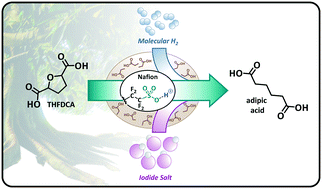Adipic acid production catalyzed by a combination of a solid acid and an iodide salt from biomass-derived tetrahydrofuran-2,5-dicarboxylic acid†
Abstract
We recently reported biomass-derived tetrahydrofuran-2,5-dicarboxylic acid (THFDCA) as a potential renewable feedstock for adipic acid (AA) production by combining HI and molecular H2 in organic acid solvents. However, the volatile and corrosive nature of HI, the catalyst, presents challenges in industrial implementation. In this work, we demonstrate an improved, less corrosive system with comparable AA yields (∼87%) using Nafion and an iodide salt, e.g., LiI, NaI and KI. Kinetic and reactivity studies indicate that the activation of THFDCA's etheric C–O bond proceeds either by direct protonation at the surface of the solid acid or by liquid-phase protons which are transported from the surface of the solid acid to the bulk solvent through an ion-exchange process. The combination of a solid acid and an iodide salt functions as a controlled release mechanism for protons without sacrificing the effectiveness of HI, while significantly reducing the corrosiveness of the reaction mixture. Further, the spent Nafion can easily be separated from the reaction mixture and regenerated by ion-exchange with minimal loss in reactivity.



 Please wait while we load your content...
Please wait while we load your content...